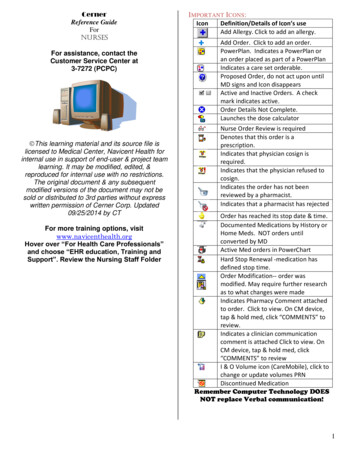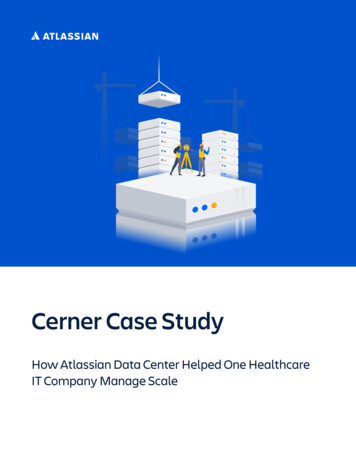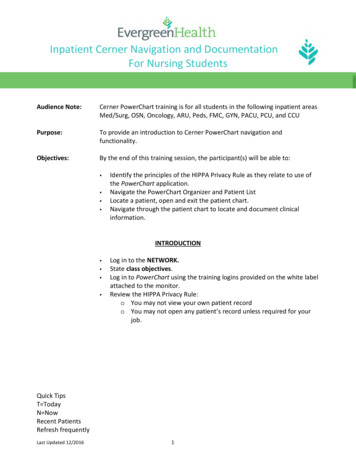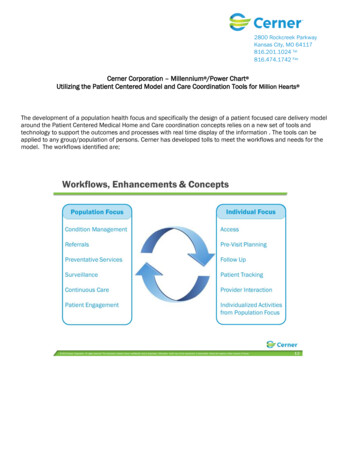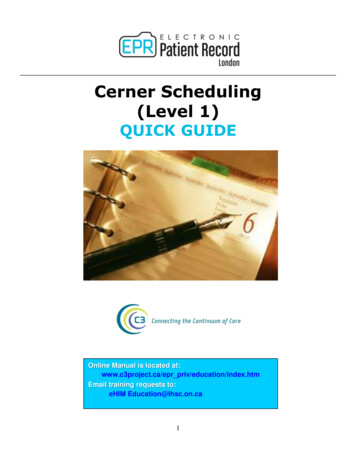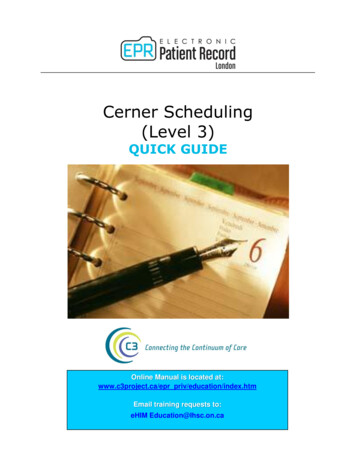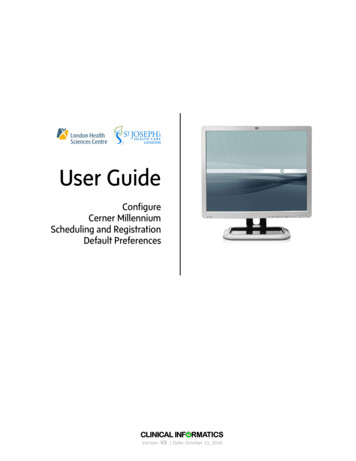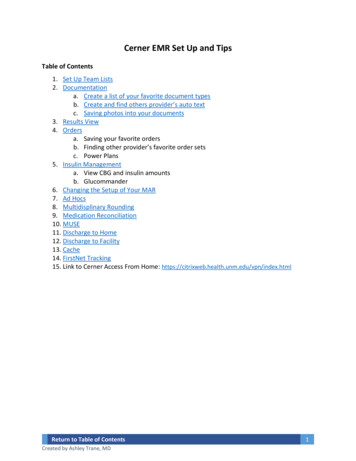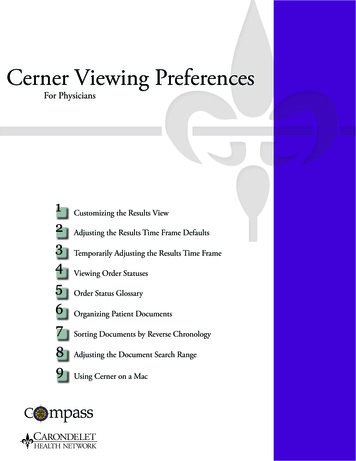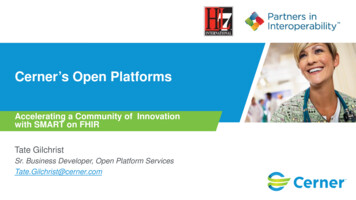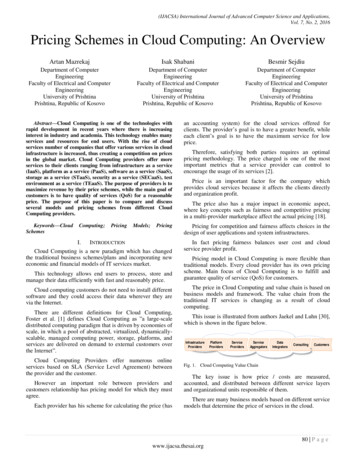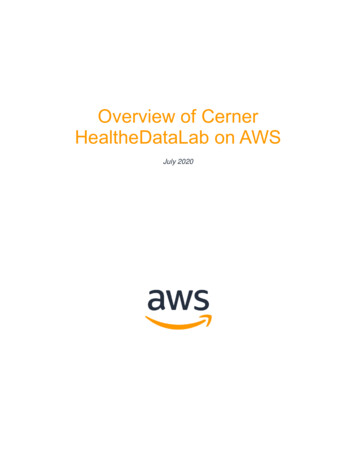
Transcription
Overview of CernerHealtheDataLab on AWSJuly 2020
NoticesCustomers are responsible for making their own independent assessment of theinformation in this document. This document: (a) is for informational purposes only, (b)represents current AWS product offerings and practices, which are subject to changewithout notice, and (c) does not create any commitments or assurances from AWS andits affiliates, suppliers or licensors. AWS products or services are provided “as is”without warranties, representations, or conditions of any kind, whether express orimplied. The responsibilities and liabilities of AWS to its customers are controlled byAWS agreements, and this document is not part of, nor does it modify, any agreementbetween AWS and its customers. 2020 Amazon Web Services, Inc. or its affiliates. All rights reserved.
ContentsIntroduction .1Service description .2Benefits .4Use case scenarios .5Related Services .6Conclusion .7Document Revisions.7
AbstractThis paper shows how HealtheDataLab can help streamline the data science workflowon AWS in a secure, elastic environment for organizations that use healthcare data.HealtheDataLab is a data science ecosystem that aims to help users at diverse carevenues to rapidly develop new insights and push those insights back into clinicalworkflows. Many organizations spend most of their data science resources boggeddown in the cleaning, managing, and organizing data. HealtheDataLab helps minimizethis work and simplifies critical tasks, such as creating patient cohorts to answer specificresearch questions.
Amazon Web ServicesOverview of Cerner HealtheDataLab on AWSIntroductionMany healthcare organizations are focusing on initiatives to use advanced analytics andintelligence in order to help analyze data and derive insights with the goal of improvingpatient outcomes. These initiatives typically require access to large amounts of data andthe computing processing power. Most organizations are faced with the need toorganize scattered datasets and access in a centralized environment to extract,cleanse, normalize, and validate data.HealtheDataLab aims to address common challenges in the traditional data scienceworkflow that can collectively slow down dataset development, data analysis, anddeployment of valuable insights into clinical and operational workflows.Dataset development breaks down into a number of tasks. Each step can prolonginsight delivery. Data ingestion – clinical and business systems use a wide variety of dataformats and frequently display various types of anomalous behavior. Accessingand retrieving needed data can be an enormous challenge, especially withoutimpacting the performance of critical systems. Data identification – identifying these data, what it means, and how to bestnormalize these clinical concepts can consume thousands of hours of labor. Forexample, as a researcher, you only want to know if a patient has been diagnosedwith asthma. Your research efforts may not require additional diagnosis such asan ICD-10 code, or a SNOMED code or a CPT code. Data cohort development extracting a group of patients with the characteristicsyou need while not contaminating them with undesirable characteristics such ascomorbidities or geographical clustering. Data ingestion infrastructure –ensuring adequate capacity, both in terms ofstorage and data processing, for data that can grow in unexpectedly in terms ofsize and complexity.Once you have a dataset ready to be analyzed, the core of the data science workflow isdesigned to you do the following: Analyze the dataset to answer the research questions Build a predictive model to more accurately forecast spend1
Amazon Web ServicesOverview of Cerner HealtheDataLab on AWS Quickly validate findings to provide relevant insights back to your organization ina secure environment Use cutting-edge artificial intelligence (AI) and machine learning (ML) tools tobuild out features Collaborate with other data scientists, researchers, and colleagues to advanceindividual research effortsAfter the data science workflow is complete, it’s time to put that data to work. Now youcan: Embed insights into clinical workflows, such as prioritizing a list of patients forcare management based on risk assessment Monitor performance and rapidly deliver updated models and improve quality Minimize technical resources required to deploy models and algorithms inproduction environmentArchitectural overviewHealtheDataLab provides an environment for model and algorithm development.Figure 1 – Reference architecture2
Amazon Web ServicesOverview of Cerner HealtheDataLab on AWSInformation is delivered through the Cerner HealtheIntent platform to theHealtheDataLab data lake hosted on Amazon Simple Storage Service (Amazon S3).From the data lake, patient longitudinal data is extracted using the AWS Data Pipelineservice and processed to create metadata describing the patient records. Theprocessing is done using Amazon EMR and then stored as a Hive metastore in arelational database hosted by Amazon Relational Database Service (Amazon RDS).Data scientists can interact with and analyze data via a Jupyter notebook. Jupyter is apopular open source tool for doing data analysis and developing machine learningmodels. Cerner has packaged the open source tool as an effortless service that doesn’trequire any server administration knowledge to use or maintain in the clientenvironment. In order to provide a responsive interface and scalable resources, eachnotebook is attached to an Amazon EMR cluster. This feature allows access to adiverse portfolio of functionality. The Cerner packages and user-defined functions arevaluable for supporting data scientist activities. Bunsen, an open source project from Cerner, enables users to load, transform,and analyze FHIR data with Apache Spark. This project has Java and PythonAPI operations that help you convert FHIR resources into Spark datasets forexploration in HealtheDataLab and across systems. Clinical Quality Language (CQL) is a programming language designed to expresslogic in the clinical domain. It can be used within both the clinical decisionsupport and clinical quality measurement domains. HealtheDataLab provides aruntime implementation of the language that executes queries in parallel on aSpark cluster over Hive databases of FHIR resources. HealtheDataLab supports working with SNOMED, LOINC, and other clinicalontologies. It can import the content to query with a series of commands tomaintain hierarchy, versioning, and relationships within the data. HealtheDataLab users plug into the CernerDiscern Ontology concepts andcontexts with convenient user-defined functions that can be run directly in SparkSQL. Concepts represent a group of codings that originate from the same ordifferent coding systems, while a context is a group of related concepts used tobetter understand and identify conditions.The development of models, including training and related activities, occur in theJupyter notebook and attached Amazon EMR cluster. Once an algorithm or machinelearning model has been developed and verified, it can be hosted using Spark Pipelineon HealtheIntent or on any other Spark Pipeline instance.3
Amazon Web ServicesOverview of Cerner HealtheDataLab on AWSBenefitsCerner HealtheDataLab supports the development and integration of rule-based,symbolic, and machine-learned algorithms for risk prediction, modeling, patient careguideline identification, and more.The ability of HealtheDataLab to ingest data from the Cerner HealtheIntent platformoffers you several benefits. The HealtheIntent platform takes data from over 1240 datasources and applies data cleansing, standardization, concept normalization, and personmatching to deliver a longitudinal patient record and populations for end users. Thisnegates the need to write custom ETL jobs for all of these tasks, including jobs for eachnew data source, jobs to cleanse and standardize data, jobs to normalize data, and thenjobs to perform person matching and build a longitudinal patient record.The collaboration of Cerner with AWS to deliver HealtheDataLab offers the followingadvantages. Amazon S3 enables storage scaling without performance degradation into theexabyte range. AWS Data Pipeline, Amazon EMR, and Amazon RDS allow the rapid extractionof metadata from patient record in a manner that scales with the amount of dataprovided. Amazon RDS provides a robust, highly available platform for storing metadatalong term. Jupyter, Amazon EC2, and Amazon EMR provide a scalable, performant, robustmechanism for rapidly analyzing data, developing machine learning models, andperforming other high impact tasks in a scalable, robust manner. The HealtheDataLab packages provided for use in the Amazon EMR Sparkenvironment simplify and accelerate many health care-related data tasks.The Cerner Discern ontology concepts and contexts enable the selection of patientsbased specific morbidities or other health criteria without having to translate thosemorbidities into ICD10 codes or specific lab result groupings. Deployment through the Spark Pipeline to the HealtheIntent platform providesthe ability to integrate insights into EHR agnostic clinical and operationalworkflows. Cerner customers have integrated with over 65 different EHRsolutions with the platform.4
Amazon Web Services Overview of Cerner HealtheDataLab on AWSHealtheDataLab provides the ability to upload datasets and insights through asimple utility command from the Jupyter Notebook into a visualization tool usingTableau software.This addresses a chronic problem with data science, informatics, and businessintelligence teams within healthcare organizations: how to rapidly deliver and updateactionable insights for use by the larger organization.Use case scenariosThe Advocate Cerner Collaborative was established to accelerate innovation inpopulation health management. With a focus on the efficient allocation of clinicalresources, predictive analytics was shown to be a key strategy in identifying high-riskpatients earlier.For instance, clinicians know that patients with heart failure have a higher risk of beingadmitted to the hospital. However, it would help clinicians to know if there is a subset ofpatients who are at high risk for short-term admission, whose care could be bettermanaged at home.Advocate and Cerner developed a risk score using HealtheDataLab and integrated itinto the Advocate care management system to prioritize patients for care managementoutreach. A year later, the team has created additional risk scores to offer this type ofprogram to people living with other conditions, like chronic obstructive pulmonarydisease and asthma. The collaborative was able to remove the technological barrier andfocus on operating efficiencies.Children’s Hospital of Orange County (CHOC Children’s) also used HealtheDataLab tobuild risk scores. CHOC Children’s wanted to better support families with children at thehighest risk of readmission. With an organized and unified dataset, and advancedcomputation inside the solution, CHOC Children’s was able to quickly build and improveits readmission model in weeks – rather than months or years like its legacy system.The organization tackled building eleven additional models in just a year with only asmall team of data scientists.“Previously, it would take a couple of months to develop a model, extract the dataand iteratively run through the algorithm. Now it only takes us a couple of days.Since streamlining our workflow, our data science team has gained tremendous5
Amazon Web ServicesOverview of Cerner HealtheDataLab on AWSefficiency. We no longer require assistance from multiple groups for all of ouractivities, and we’re not constrained by hardware limits.”- Louis Ehwerhemuepha, Ph.D., Data scientist, CHOC Children’sAnother example of results with HealtheDataLab is the AWS and Cerner collaborationto create a model for predicting the onset of chronic conditions, such as congestiveheart failure1. The model was demonstrated to be capable of predicting the onset ofcongestive heart failure months in the future. With this model, providers can implementstrategies designed to reduce risk factors, such as control high blood pressure, highcholesterol, and diabetes. This model can also assist researchers in evaluatinginterventions that have the potential to delay or avert the development of otherconditions with high mortality, morbidity rates, and significant costs.The data preparation and analysis were both carried out using HealtheDataLab. Data from HealtheIntent was syndicated into Amazon S3 as Parquet files in aFHIR-inspired data model. The database information was stored in the Hive metastore. The EMR File System (EMRFS) was used to access the data from Amazon EMRinstances with Spark, where data analysis and processing was performed. Jupyter notebooks were used as the interface and PySpark was used to analyzethe data. Once the feature sets were isolated with information from demographics,conditions, lab results (vitals), and procedure tables, they were saved as Pandasdata frames and NumPy arrays.The power of this model is not just limited to congestive heart failure, but is generallyapplicable to predicting the onset of other chronic conditions.Related Services HealtheIntent Amazon S3 AWS Data Pipeline Amazon EMR6
Amazon Web Services Amazon RDS Amazon EC2 Jupyter Apache SparkOverview of Cerner HealtheDataLab on AWSConclusionHealtheDataLab accelerates the development of models and algorithms fororganizations that use healthcare data. Time-to-value is an important component of anydata activity, whether developing improved clinical interventions or financially planninghow to deliver health in the future. If you have an interest in using HealtheDataLab,contact Cerner for help with getting started with HealtheDataLab.Document revisionsDateDescriptionJuly 2020First publicationNotes1Effectiveness of LSTMS in Predicting Congestive Heart Failure Onset7
Cerner HealtheDataLab supports the development and integration of rule-based, symbolic, and machine-learned algorithms for risk prediction, modeling, patient care guideline identification, and more. The ability of HealtheDataLab to ingest data from the Cerner
